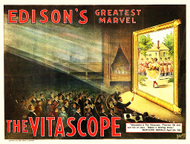Beyond the Cinématographe: How Cinema Evolved After the Lumière Brothers
Posted by Julio Urbay on 21st Jun 2025
When the Lumiere brothers unveiled the Cinematographe in 1895 they did not just invent a projector they sparked a cultural revolution. Their hand cranked device that could record develop and project 35mm film turned moving pictures from a solitary novelty into a shared experience. What came next was a remarkable time as the years that followed their invention unleashed a wave of innovation competition and creativity that shaped the future of cinema.
The Vitascope and Edison’s Pivot (1896)
In the United States, Thomas Edison had already introduced the Kinetoscope—a peephole viewer for individual film experiences. But after witnessing the Lumières’ success, Edison quickly shifted gears. In 1896, he began marketing the Vitascope, a projector developed by Thomas Armat and Charles Francis Jenkins. Unlike the Kinetoscope, the Vitascope could project films onto a screen for a crowd, bringing American audiences into the age of communal cinema.
The Mutoscope and Biograph: Bigger Film, Sharper Images
Around the same time, the American Mutoscope Company introduced the Mutoscope, a flip-card viewer, and later the Biograph projector, which used 68mm film—nearly double the width of the Lumières’ 35mm. The result was sharper, more detailed images. Biograph became a major player in early American cinema, launching the careers of directors like D.W. Griffith and actors like Mary Pickford.
Georges Méliès and the Birth of Film Magic
While the Lumières focused on real-life scenes, French magician Georges Méliès saw film as a canvas for imagination. In 1902, he released Le Voyage dans la Lune (A Trip to the Moon), a whimsical, effects-laden journey that introduced narrative storytelling, set design, and cinematic trickery. Méliès pioneered techniques like multiple exposures, dissolves, and hand-painted color—turning film into fantasy.
Pathé, Gaumont, and the Rise of Film Studios
In France, companies like Pathé Frères and Gaumont began mass-producing films and equipment. Pathé’s rooster logo became synonymous with early cinema, and the company built a global distribution network. These studios didn’t just make movies—they industrialized them, creating the first film catalogs, newsreels, and serialized content.
Nickelodeons and the American Boom (1905–1910)
Back in the U.S., the first nickelodeon opened in Pittsburgh in 1905, charging five cents for short films. Within five years, thousands of these storefront theaters had popped up across the country. This explosion in demand fueled the growth of American film production and led to the establishment of permanent studios in New York and eventually Hollywood.
Standardizing 35mm: The Format That Stuck
Despite early experiments with wider film formats, the Lumières’ 35mm gauge—with its 1.33:1 aspect ratio—became the industry standard. Edison adopted it, as did Pathé and Biograph. Its balance of image quality, cost, and mechanical reliability made it the backbone of cinema for over a century.
Conclusion: From Invention to Industry
The Cinématographe was the match that lit the fire, but what followed was a global race to refine, expand, and commercialize the moving image. From Edison’s Vitascope to Méliès’ magical narratives, from nickelodeons to international studios, the years after 1895 were a whirlwind of invention and ambition. The Lumière brothers may have opened the door—but the world rushed through it, eager to see what came next.

